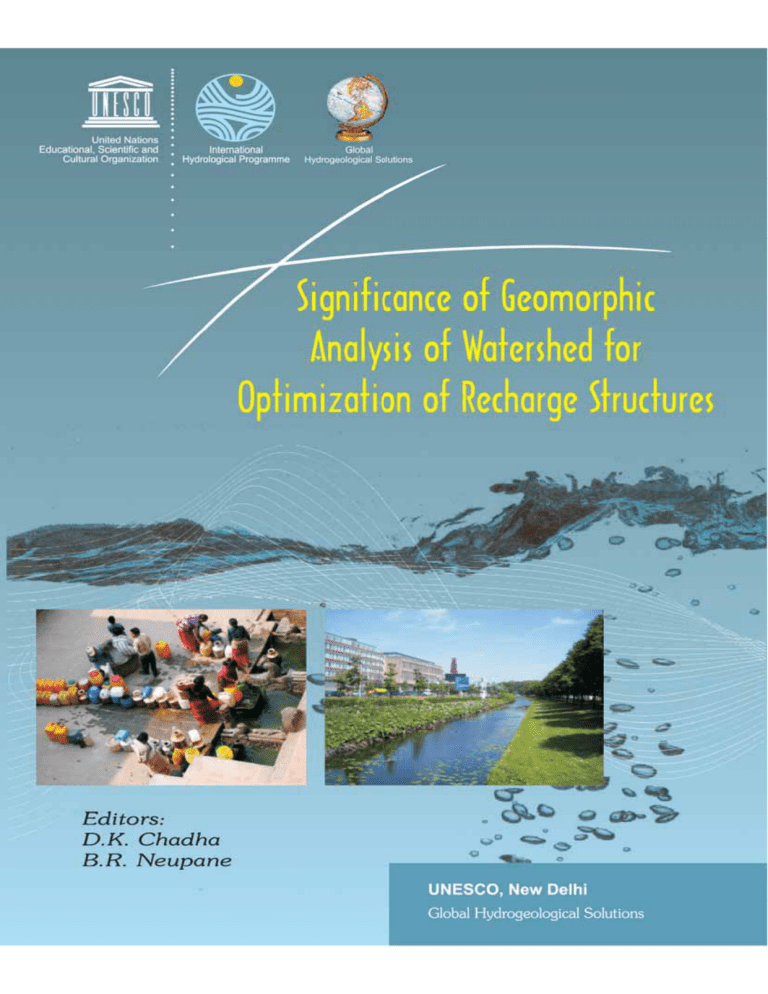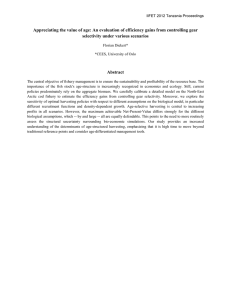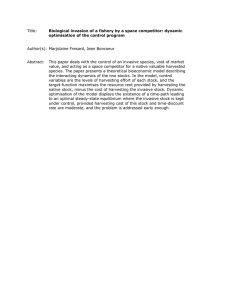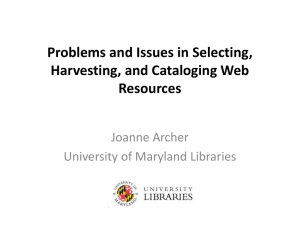Vatrak Unesco Aug 25 2015
advertisement

Significance of Geomorphic
Analysis of Watershed for
Optimization of Recharge Structures
Dr. D.K. Chadha
Dr B. R. Neupane
CONTENTS
Sr.No
Title
Chapter 1: INTRODUCTION
Introduction
Watershed and classification
Watershed
Importance of Macro Watershed Development
Nimbahera Watershed and Classification
According to Size Classification
Based on Drainage Classification
Based on Shape Classification
1.1
1.2
1.2.1
1.2.2
1.2.3
1.2.3.1
1.2.3.2
1.2.3.3
2.1
2.2
2.2.1
2.2.2
2.3.3
2.3
2.3.1
2.3.2
2.3.3
2.3.4
2.3.5
2.3.6
2.3.7
2.3.8
2.3.9
2.3.10
2.3.11
2.3.12
2.3.13
2.4
2.4.1
Page no
1
1
2
2
2
2
3
3
Chapter 2: DRAINAGE CLASSIFICATION
Drainage Classification
4
Geomorphologic Features of Macro Watershed
5
Drainage Basin
6
Linear Aspects
6
Areal Aspects
8
Analytical Parameters of Macro Watershed
9
Stream Order
9
Area
9
Perimeter
9
Flow Direction (Slope)
9
Bifurcation Ratio
9
Stream Length Ratio
9
Drainage Density
10
Stream Frequency
10
Form Factor
11
Circulatory Ratio
11
Elongation Ratio
12
Basin Length
13
Relief Aspects
13
Characteristics of Macro Watershed
13
Physiography 13
Chapter 3: MORPHOMETRIC ANALYSES OF THE
WATERSHEDS
3.1
Macro Watershed No. 1
15
3.2
Macro Watershed No. 219
3.3
Macro Watershed No. 3
21
3.4
Macro Watershed No. 4
23
3.5
Macro Watershed No. 5
25
3.6
Macro Watershed No. 6
27
3.7
Macro Watershed No. 7
29
3.8
Macro Watershed No. 8
32
3.9
Macro Watershed No. 9
34
3.10
Macro Watershed No. 10
37
3.11
Macro Watershed No. 11
39
3.12
Macro Watershed No. 12
41
3.13
Macro Watershed No. 13
43
3.14
Macro Watershed No. 14
45
4.1
4.2
4.3
4.4
4.5
4.6
4.7
4.8
4.9
Chapter 4: Conclusion
Bifurcation Ratio (Rb)
50
Drainage Density (Dd)
50
Stream Length Ratio
50
Circulatory Ratio
50
Elongation Ratio
50
Percolation Tank
51
Check Dams
52
Subsurface Barriers
52
Point Recharge Structures
53
Site Selection for Rain Water Harvesting
and Artificial Recharge to Ground Water in
Vatrak Sub-Watershed, Sabarmati Basin,
Gujarat India
Based on Geo-informatics Multithematic Multi-criteria Evaluation
Dr.R.C.Jain1, A.P.Bhavsar2, B.S. Patel3, Naveenchandra N. Srivastva4
and
Khalid Mahmood4
Abstract
multi-criteria evaluation, different types of structures
suited for rain water harvesting and artificial recharge
to groundwater have been suggested for providing
sustainability to the water-stressed aquifers in the
sub-watershed.
Rain water harvesting and artificial recharge
to groundwater has gained momentum in recent
years for providing sustainability to water-stressed
aquifers as natural replenishment of ground water
reservoir is a slow process and is often unable to keep
pace with the excessive and continued exploitation
of groundwater resources. A case study of Vatrak
sub-watershed, Sabarmati basin, has been carried
out to identify suitable sites for rain water harvesting
structures. The various geo-informatics based
thematic maps such as land use map, geomorphology
map, slope map, drainage map, Digital Elevation
Model, etc. were prepared in order to evaluate the
sub-watershed. With the help of geo-visualization of
water resources and other relevant natural resource
data pertaining to Vatrak sub-watershed, issues of
knowledge sharing and information communication
can be effectively addressed. Based on multi-thematic
1. Background
The Vatrak River originates in Durgapur
district of Rajasthan. The total area of Vatrak sub
watershed is 598.4 sq kms. The study area falls in
Sabarkantha district (Gujarat). Vatrak is a rain fed
river and principal tributary to Sabarmati river. Owing
to fairly low rainfall, the Sabarmati river basin has
one of the lowest water wealth potentials in India.
The basin is highly exploited in its water resources
front. The study area falls in the hot and semiarid region of northern Gujarat. Topographically,
the area of Sabarkantha district is undulating.
86
3.1. Geology
Geologically, the area comprises various types of
igneous, sedimentary and metamorphic formations,
such as basalt, alluvium, quartzite, etc. The rainfall
pattern is uneven and erratic in the study area. As
climatic conditions are unfavourable for creating
surface storage, water harvesting structures have to
be adopted for diverting most of the surface storage
to the groundwater reservoirs within the shortest
possible time. The present study aims to identify
suitable locations to get maximum benefits from
recharge structures.
Geologically the area comprises various
types of igneous, sedimentary and metamorphic
formations, such as basalt, quartzite, schist,
alluvium, carbonate rock (Lower Proterozoic), etc.
(Fig. 1). Metamorphic rocks cover the northern part
of the study area. The central and southern parts
are occupied by alluvium, channel fill deposits,
volcanic rocks (Porphyritic and amygdular basalt of
Cretaceous to Eocene age), etc. Physiographically,
the study area can be divided into two zones, viz. the
hilly regions and the plains. Hills cover the northern
parts, whereas the plains are confined towards the
south.
2. Objectives
The study has the following major objectives:
1. To generate thematic maps of various natural resources.
2. To integrate the thematic maps through the GIS
environment
3. To identify suitable sites for water harvesting
structures
4. Geo-visualization of data in GIS environment
2.1. Problems intended to be addressed by this
study
Figure 1. Geological Map of Study Area
a) Rain water harvesting
3.2. Drainage
b) Optimize recharge to groundwater for waterstressed aquifers in the study area
The area is drained by the southwesterly
flowing river Vatrak and its tributaries. The stream
flow in these regions is mostly restricted to the rainy
season. The surface drainage is located above the
water table. The drainage pattern is dendritic.
3 Pre-study status
Some check dams have been constructed in
Sabarkantha district to raise the groundwater level
in the vicinity. During the rainy season in 2007, a
flood alert was sounded in villages on the banks of
the Vatrak River. (http://timesofindia.indiatimes.
com /India/Gujarat on_flood_alert_20_dead_in_
MP_/articleshow/2189767.cms). Groundwater is
available from the weathered zone, cracks, fractures
and joint planes in limited quantity through wells,
hand pumps and bore wells. Owing to some recharge
structures constructed in Sabarkantha district water
level has risen up to 24 m (http://www.gwssb.org/
impact/sabarkantha.pdf).
3.3. Rain Water Harvesting and Artificial Recharge to Groundwater
Water harvesting is a method of water
collection applied in arid and semi-arid regions,
where rainfall is either not sufficient to sustain a
good crop and pasture growth or where, due to
the erratic nature of precipitation, the risk of crop
failure is very high (www.geotunis.org/2009/file/
ppt/Dr Mutawakil Obeidat. ppt). Water harvesting
can be accomplished through in situ harvesting, soil
87
conservation methods, and increasing infiltration for
recharge of groundwater. Water harvesting structures
are extremely important to conserve precious natural
resources like soil and water, which is depleting
every day at an alarming rate. In the study area,
precipitation is variable over time and space due
to the monsoon climate and land-hill topography.
Several water harvesting structures have been
constructed at appropriate sites that check floods
and provide irrigation to downstream. There are
always strong links between soil conservation and
water conservation measures.
The present study envisages the identification of
potential suitable sites for rain water harvesting and
artificial recharge to groundwater in the watershed
with the help of geo-informatics.
3.4 Source Water
Availability of source water is one of the
basic prerequisites for taking up any water harvesting
structure study. The source water available in the
Vatrak sub-watershed is in situ precipitation. The
availability of water varies considerably from place
to place.
Water
harvesting
structures
store
rainwater to be used for irrigation and increase
groundwater recharge (https://engineering.purdue.
edu/~abe527/Projects_2006 /Macaluso Trepanier.
pdf). The problem of water shortage in arid and
semi-arid regions is one of low rainfall and uneven
distribution throughout the season, which makes
rainfed agriculture a risky enterprise (http://oldwww.
wii.gov.in/eianew/eia/dams and development /
kbase/ contrib/opt158.pdf).
4. Application of Geo-informatics
Thematic maps are derived from remote
sensing data and integrated in GIS to evaluate
suitable sites for water harvesting. Remote sensing is
of immense use for natural resources mapping and
generating necessary spatial database required as an
input for GIS analysis. GIS is a tool for collecting,
storing and analysing spatial and non-spatial data. It
can be used to evaluate appropriate natural resource
development and management action plans. Both
these techniques can complement each other to be
used as an effective tool for selecting suitable sites
for water harvesting structure (ICRAF, 2005). The
application of GIS as an integrating tool to store,
analyse and manage spatial information to facilitate
decision-making by providing identification of
harvesting sites has been applied by de Winnaar et
al., (2007).
Khan 1992; Karla 2005, made significant
studies in the construction of check dams and
percolation ponds.
Water harvesting has the potential to
increase the productivity of arable and grazing land
by increasing the yields and by reducing the risk of
crop failure. They also facilitate re- or afforestation
or agroforestry (http://oldwww.wii.gov.in/eianew/
eia/dams and development/kbase/contrib/opt158.
pdf). Locations of existing water harvesting structures
on various streams of study area are shown in Fig.2.
5. Database
Work
Components
for
Present
Objectives of the study can be met by
obtaining the following water resource data and
other natural resource data.
Water resource data consists of
Rainfall data (Data source: Gujarat Water Resource
Development Corp., Gandhinagar)
Drainage Map - {Data source: satellite imagery
LISS III (IRS1C data product, spatial resolution 23.5
Figure 2. Location of Existing Water Harvesting
Structures in Study Area
88
m) and LISS IV (IRS-P6 data product, spatial resolution 5.8 m)}
fact that locations are arranged regularly permits the
raster GIS to infer many interesting associations
among locations.
Water bodies – {Data source: satellite imagery LISS
III (IRS1C data product, spatial resolution 23.5 m)
and LISS IV (IRS-P6 data product, spatial resolution
5.8 m)}
Other natural resource data consists of
•• Geology (District Resource Map, Sabarkantha
District, Gujarat – Publisher Geological Survey of India, 2002).
•• Geomorphology [satellite imagery {LISS III,
(IRS1C data product, spatial resolution 23.5 m),and
LISS IV (IRS-P6 data product, spatial resolution 5.8
m) }].
Figure 3. Aster Digital Elevation Model of Study
Area
•• Landuse [satellite imagery {LISS III (IRS1C data
product, spatial resolution 23.5 m) and LISS IV
(IRS-P6 data product, spatial resolution 5.8 m) }].
6.. Methodology
•• Soil [National Bureau of Soil Sciences and Landuse Planning, Nagpur and LISS III (IRS1C data
product, spatial resolution 23.5 m) satellite imagery].
Various thematic maps were prepared through
visual interpretation of satellite data, showing land
use map, geomorphology map, soil map, drainage
map, water bodies map, etc. The digital analysis
was carried out using GIS software. Geo-informatics
based multi-criteria evaluation (MCE) was adopted
for this study. MCE combines the information from
several criteria. The stepwise details of methodology
adopted for evaluation of the Vatrak sub-watershed is
presented through flowchart (Fig. 4). The following
are evaluations of various types of information:
•• NDVI : Normalized Difference Vegetative Index
(Downloaded from http://dsc.nrsc.gov.in:14000/
DSC/Drought/NDVIimage GalleryStateTable.jsp)
5.1. Aster DEM (Digital Elevation Model)
Aster Dem with 30m resolution tile number
ASTGTM_N23E073 was downloaded (http://
www.gdem.aster.ersdac.or.jp/) and was used for this
study. The DEM was further analysed to remove pits
(sinks). Digital Elevation Model (DEM) shows that
area of study consists of several gentle slopes in
the southern part and relatively steep slope in the
northern part (Fig. 3).
6.1. Rainfall
The knowledge of rainfall characteristics for
a given area is one of the prerequisites for designing
a water harvesting system. In the study area, rainfall
is typically monsoonal in nature. Plot of rainfall
data versus months of the year 2009 are shown in
Fig. 5 In resource evaluation of a sub-watershed,
the average depth of rainfall of a number of rain
gauges is required. The average was obtained by the
Theissen polygon method. Weighted average using
Theissen Polygon method is shown in Table 1.
A digital elevation model (DEM) is a digital file
consisting of terrain elevations for ground positions
at regularly spaced horizontal intervals. A DEM in
grid format stores elevations in a regular array, very
much like a raster image comprised of pixels. DEM is
used in the generation of three-dimensional graphics
displaying terrain slope, aspect (direction of slope),
and terrain profiles between selected points (http://
rockyweb.cr.usgs.gov/elevation/dpi_dem.html). The
89
Satellite data
Geo-referencing
Thematic Maps
Land use Map
Drainage and water
bodies Map
Slope
Soil Map
Geomorphology
Digitization and Editing
Geology
NDVI
Attribute Assignment
Application of MCE
3D visualization
Site Suitability Map
Figure 4. Methodology for Evaluation of Sub-watershed to Identify Locations of Suitable Rain water
Harvesting Structures
Figure 5. Plot of Rainfall Data Versus Months (for the year 2009)
90
Sr. No.
1
2
3
4
5
6
7
8
Station Name
Year
Effective Area
(km2)
Ambliyara
Betawada
Modasa
Bayad
Vadgam
Bhempoda
Malpur
Volva
2009
2009
2009
2009
2009
2009
2009
2009
88.75
11.62
37.60
127.96
87.63
237.31
0.01
7.54
Total
Rain fall
619.5
448.2
615
1003
572
735
633
578.3
2009
Weight
14.83
1.94
6.28
21.38
14.64
39.66
0.002
1.26
598.43
Weighted Average Rainfall
(mm)
91.88
8.70
38.64
214.46
83.76
291.47
0.01
7.29
736.2187
Table 1. Weighted Average Rainfall Using Theissen Polygon Method
6.2. Land Use or Vegetation Cover
6.3. Geomorphology
Vegetation Is another important parameter
that affects the surface runoff. From the studies in
West Africa (Tauer and Humborg 1992) and Syria
(Prinz et al., 1999) proved that an increase in the
vegetation density results in a corresponding increase
in interception losses, retention and infiltration rates
which consequently decrease the volume of runoff.
In the study area, a total of 6 land use classes were
identified, viz. agriculture, wasteland, built up, etc
(Fig. 6).
Different geomorphic units have different
groundwater prospects. Alluvial plains and flood
plains have got good groundwater prospects, while
hills consisting of barren rocks have got poor
groundwater prospects. A total of five geomorphic
units were identified in the study area (Fig. 7).
Figure 7. Geomorphological Map of Study Area.
6.4. Topography
The area of study is characterized by wide
river valleys and structural hills reaching a maximum
of about 199 m in the northern part. Topography
controls the extent of runoff and retention.
Figure 6. Land Use Map of Study Area.
91
6.5. Soil Type
6.6. Stream Orders
All stream segments were assigned orders
(Fig. 8). The number of segments of each order was
then counted to yield the figures in Table 2.
The suitability of a certain area either as catchment
or as cropping area in water harvesting depends
strongly on its soils characteristics. Four different
classes of soil were mapped in the study area.
Figure 8. Stream Orders and Water Bodies.
Sr. No.
Stream Order
Number of
Sgments
Length of Segments
(Metre)
1
1
959
471162.96
2
2
270
163853.79
3
3
71
126778.85
4
4
35
38546.53
5
5
17
61604.99
1352
861947.13
TOTAL
Table 2. Details of Stream Orders
92
6.7. Slope
Based on geo-informatics based multi-criteria
evaluation different potential suitable sites for various
water harvesting structures, viz. check dams, nala
plugs, bori bund, etc. were identified (Fig. 9).
There were a total of six categories of slope
pertaining to the study area These categories were
used to explore potential suitable sites for several
water harvesting structures. 0 – 1 per cent slope
category is the most prevalent one in the study
area.
7. Multi criteria evaluation of the Vatrak
sub-watershed for identification of potential
sites for water harvesting structures
The following criteria were used for making
decisions on selecting potential suitable sites for
various water harvesting structures:
Figure 9. Location of Potential Suitable Sites for
Water Harvesting Structures on Drainages
The rainfall in the sub-watershed should be preferably less than 1000 mm / annum (http://cgwb.
gov.in/documents/Manualon Artificial Recharge of
Ground Water. pdf).
8. 3-D Visualization
The stream bed should be 5 to 15 m wide.
•• The area downstream of the water harvesting
structure should have irrigable land under well irrigation.
Geo-visualization provides easy and efficient
accessing, analysing, and viewing of water resource
data. In the present work, GIS software is used for
3-D visualization. Details of geo-visualization of
water resources and other natural resource data are
as follows:
•• The rock/soil exposed in the ponded area should
be adequately permeable to cause groundwater recharge.
Overlay of land use information on ASTER DEM
•• The land use may be near agricultural land.
Overlay of geomorphological information on ASTER DEM
•• The slope should be less than 15 per cent.
•• The depth to water level in the area should remain more than 3 m below ground level during the
post-monsoon period.
Overlay of geological information on ASTER DEM
Overlay of slope information on ASTER DEM
•• Soft rocks are preferred for water harvesting
structures.
Overlay of soil information on ASTER DEM
Overlay of drainage and water bodies information
on ASTER DEM
•• Hard rocks with lineaments are preferred for water harvesting structures.
•• The type of soil should be coarse loam.
Overlay of pre-monsoon NDVI image (Year 2009)
on ASTER DEM
•• Second and third order streams are preferred for
construction of check dams.
Overlay of post-monsoon NDVI image (Year 2009)
on ASTER DEM
•• First and Second order streams are preferred for
construction of boribund and nala-plug.
Overlay of drainage and potential sites for water harvesting structures on ASTER DEM (Fig.10)
93
visualization of water resource data pertaining to
the Vatrak sub-watershed was carried out using geoinformatics. In the present study, overlay of water
resources and other natural resource data was done
on ASTER DEM. At present, there are a total of
159 existing water harvesting structures. Using
geo-informatics based technologies, 670 potential
appropriate sites were identified for various water
harvesting structures.
Disclaimer
Maps presented in this paper are indicative
only. Maps are not to scale.
Figure 10. Overlay of Drainage and Potential
Sites for Water Harvesting Structures on Aster
DEM
9. Results and Discussion
Acknowledgements
The authors express gratitude to Mr. T. P.
Singh, Director, BISAG, Gandhinagar for providing
necessary support and permission to publish this
work. The authors are thankful to Dr. V. K. Agarwal,
Distinguished Professor (Bhaskaracharya Institute
for Space Applications and Geo-informatics,
Gandhinagar) for providing necessary guidance. The
project funding by NRDMS Division, Department
of Science and Technology, Government of India
is gratefully acknowledged for part of the study.
The authors also acknowledge Narmada, Water
Resources, Water Supply and Kalpsar Department,
Gandhinagar, Gujarat for providing the relevant
information regarding existing water harvesting
structures.
Geo-visualization of spatial, aspatial and
multilayered water resource information can be an
effective tool for multi-purpose applications. Land
use map of the study area consists of 6 classes.
Geo-morphology maps of the study area consists
of 5 classes. The geological map shows 5 classes.
The suitability of water harvesting structures can be
confirmed as the structure is proposed on appropriate
drainage order and satisfies the conditions of land
use, soil, geomorphology, slope, etc.
A total of 128 potential sites of check dam,
149 potential sites of nala plug and 393 sites of bori
bund were identified based on multi-criteria analysis.
According to MCE, potential sites are located on low
order stream. Sites have distribution throughout the
sub-watershed.
10. Summary and Conclusions
The Vatrak sub-watershed faces a water
scarcity problem. Keeping this in view, an attempt
has been made to evaluate the sub-watershed for
site suitability of water harvesting structures. Geo-
94
References
1. Central Ground Water Board, 2007. Manual on Artificial Recharge of Ground Water.
2. de Winnaar, G., Jewitt, G. P. W. and Horan, M. 2007. A GIS-based approach for identifying potential runoff harvesting sites in the
Thukela River basin, South Africa. Physics and Chemistry of the Earth, Parts A/B/C, 32 (15-18): 1058-1067.
3. Kalra B. S. 2005. Making of rain-water harvesting movement in Saurashtra, Gujarat, India : A case study. Abstracts of national
conference on watershed management of sustainable production liveli hood and environmental security (WAMSP 2005) held at
G.B. Pant University of Agriculture and Technology, Pantnagar, Uttarakhand from May 19-21, pp. 67.
4. Sing h, J. P., Sing h Darshdeep and Litoria, P.K., 2009. Selection of Suitable Sites for Water Harvesting Structures in Soankhad
Watershed, Punjab Using Remote Sensing and Geographical Information System (RSandGIS) Approach – A Case Study, Journal
of the Indian Society of Remote Sensing, Springer, Volume 31-Number 1- March 2009: 21-35.
5. Oweis, T., A. Hachum, and J. Kijne. 1999. Water harvesting and supplementary
irrigation for improved water use efficiency in dry areas. SWIM Paper 7. Colombo,Sri Lanka: International Water Management
Institute.
6. Prinz, D., T. Oweis and A. Oberle. 1998. Rainwater harvesting for dry land
agriculture: Developing a methodology based on remote sensing and GIS.
Proceedings, XIII International Congress Agricultural Engineering, 02-06.02.1998 .ANAFID, Rabat,
Morocco.
7. http://oldwww.wii.gov.in/eianew/eia/dams and development/kbase /contrib /opt 158.pdf
8. https://engineering.purdue.edu/~abe527/Projects_2006/MacalusoTrepanier.pdf
9. www.itc.nl/library/papers_2010/msc/wrem/munyao.pdf, accessed on August 13, 2010.
10. ICRAF, 2005. Potential for Rainwater Harvesting in Africa. A GIS Overview, ICRAF and UNEP.
11. http://rockyweb.cr.usgs.gov/elevation/dpi_dem.html, accessed on November 24, 2007.
12. http://www.gsd.harvard.edu/geo/manual/dem, accessed on November 24, 2007.
13. http://www.reliefshading.com/analytical/dem.html, accessed on November 24, 2007.
14. http://timesofindia.indiatimes.com/India/Gujarat_on_flood_alert_20_dead_in
_MP_/articleshow/2189767.cms, accessed on January 5, 2005.
15. http://dsc.nrsc.gov.in:14000/DSC/Droug ht/NDVIimageGalleryStateTable.jsp
16. http://www.gwssb.org/impact/sabarkantha.pdf
17. http://www.gdem.aster.ersdac.or.jp/
18. www.geotunis.org/2009/file/ppt/Dr mutawakil obeidat.ppt, accessed on August 13, 2010.
95




